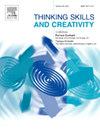Enhancing creativity and cognitive skills in healthcare curricula: Recommendations from a modified delphi study on virtual reality integration
IF 3.7
2区 教育学
Q1 Social Sciences
引用次数: 0
Abstract
The incorporation of Virtual Reality (VR) into healthcare education presents significant opportunities to enhance creativity, critical thinking, and overall learning outcomes, yet comprehensive frameworks to guide its implementation remain sparse. To address this gap, this study employed a three-round modified Delphi process with international healthcare and technology experts, aiming to establish evidence-based guidelines for effectively integrating reusable VR resources into healthcare curricula. In Round 1, nine thematic categories emerged from open-ended questions, encompassing theoretical frameworks, instructional design, resource development, and organizational strategies. In Round 2, 62 statements derived from these themes were refined and rated by experts, focusing on key elements such as managing cognitive load, improving learner engagement, and fostering affective and psychomotor skills. Round 3 validated and prioritized the recommendations, aligning them with models like the Cognitive-Affective Model of Immersive Learning (CAMIL). Key results include practical strategies to enhance learning across cognitive, affective, and psychomotor domains, ensuring that VR resources are co-created with learners, integrate smoothly into existing systems, and leverage immersive learning analytics to continuously assess and optimize their impact. By offering structured guidance on pedagogical approaches, theoretical underpinnings, and resource design, this study provides educators and policymakers with actionable tools for evaluating, scaling, and critically comparing VR applications in healthcare education. Ultimately, these recommendations support VR's transformative role in reimagining healthcare training, encourage the development of creative problem-solving skills among learners, and call for sustained academic inquiry to fully realize VR's benefits in this field.
提高医疗保健课程中的创造力和认知技能:来自虚拟现实整合的修正德尔菲研究的建议
将虚拟现实(VR)整合到医疗保健教育中,为增强创造力、批判性思维和整体学习成果提供了重要机会,但指导其实施的综合框架仍然很少。为了解决这一差距,本研究与国际医疗保健和技术专家一起采用了三轮改进的德尔菲过程,旨在建立循证指南,有效地将可重复使用的VR资源整合到医疗保健课程中。在第一轮中,从开放式问题中产生了九个主题类别,包括理论框架、教学设计、资源开发和组织策略。在第二轮中,专家们对来自这些主题的62个陈述进行了提炼和评分,重点是管理认知负荷、提高学习者参与度、培养情感和精神运动技能等关键因素。第三轮验证并优先考虑这些建议,将它们与沉浸式学习的认知-情感模型(CAMIL)等模型对齐。主要成果包括增强认知、情感和精神运动领域学习的实用策略,确保VR资源与学习者共同创建,顺利集成到现有系统中,并利用沉浸式学习分析来持续评估和优化其影响。通过对教学方法、理论基础和资源设计提供结构化指导,本研究为教育工作者和政策制定者提供了可操作的工具,用于评估、扩展和批判性地比较VR在医疗保健教育中的应用。最终,这些建议支持VR在重塑医疗培训中的变革作用,鼓励学习者发展创造性解决问题的技能,并呼吁持续的学术研究,以充分实现VR在这一领域的好处。
本文章由计算机程序翻译,如有差异,请以英文原文为准。
求助全文
约1分钟内获得全文
求助全文
来源期刊

Thinking Skills and Creativity
EDUCATION & EDUCATIONAL RESEARCH-
CiteScore
6.40
自引率
16.20%
发文量
172
审稿时长
76 days
期刊介绍:
Thinking Skills and Creativity is a new journal providing a peer-reviewed forum for communication and debate for the community of researchers interested in teaching for thinking and creativity. Papers may represent a variety of theoretical perspectives and methodological approaches and may relate to any age level in a diversity of settings: formal and informal, education and work-based.
 求助内容:
求助内容: 应助结果提醒方式:
应助结果提醒方式:


